@1kbfree
2019-05-29T07:16:23.000000Z
字数 16643
阅读 3634
信息收集之我见
web安全
来源网络,回馈网络
对一个网站挖掘的深浅来说就得看你收集的如何,这说明信息收集在漏洞挖掘中是非常的重要的。
子域名收集
子域名收集是最简单的收集手法之一,有很多在线的工具可以直接套用,这里分享几个我经常用的。
开心的时候用用这个扫描器
为什么这么说,因为这是我写的(你生气用的话我怕我屏幕里突然冒出一个拖孩)
import requestsimport threadingfrom bs4 import BeautifulSoupimport reimport timeurl = input( 'url(如baidu.com): ' )head={'User-Agent':'Mozilla/5.0 (Windows NT 10.0; WOW64) AppleWebKit/537.36 (KHTML, like Gecko) Chrome/58.0.3029.110 Safari/537.36 SE 2.X MetaSr 1.0'}ip = 'http://site.ip138.com/{}'.format( url )# domain_url = url.split('.')# domain_url = domain_url[1]+'.'+domain_url[2]domain_url = urldomain = 'http://site.ip138.com/{}/domain.htm'.format( domain_url )t = time.strftime("%Y-%m-%d"+'_', time.localtime())html_file = open( url+'_'+t+'.html','w' )html_file.write( '''<head><title>%s的扫描结果</title><link rel="stylesheet" href="https://cdn.staticfile.org/twitter-bootstrap/3.3.7/css/bootstrap.min.css"><script src="https://cdn.staticfile.org/jquery/2.1.1/jquery.min.js"></script><script src="https://cdn.staticfile.org/twitter-bootstrap/3.3.7/js/bootstrap.min.js"></script><style>pre{margin: 0 0 0px;}</style></head><ul id="myTab" class="nav nav-tabs navbar-fixed-top navbar navbar-default"><li class="active"><a href="#ip" data-toggle="tab">IP历史解析</a></li><li><a href="#cms" data-toggle="tab">CMS识别</a></li><li><a href="#domain" data-toggle="tab">子域名信息</a></li></ul><br><br><br><br><div id="myTabContent" class="tab-content">'''%url )class IP( threading.Thread ):def __init__(self, ip):threading.Thread.__init__(self)self.ip = ipdef run(self):r = requests.get( self.ip,headers = head )html = r.textbs = BeautifulSoup(html, "html.parser")html_file.write('<div class="tab-pane fade in active" id="ip">')for i in bs.find_all('p'):ipc = i.get_text()ip_html = '<pre>{}</pre>'.format( ipc )html_file.write( ip_html )html_file.write('</div>')class CMS( threading.Thread ):def __init__(self, cms):threading.Thread.__init__(self)self.cms = cmsdef run(self):cms = requests.post('http://whatweb.bugscaner.com/what/', data={'url': self.cms}, headers = head)text = cms.textWeb_Frameworks = re.search('"Web Frameworks": "(.*?)"]', text)Programming_Languages = re.search('"Programming Languages":(.*?)"]', text)JavaScript_Frameworks = re.search('"JavaScript Frameworks": (.*?)"]', text)CMS = re.search('"CMS": (.*?)"]', text)Web_Server = re.search('"Web Servers": (.*?)"]', text)if CMS:CMS = CMS.group(1)+'"]'if Programming_Languages:Programming_Languages = Programming_Languages.group(1)+'"]'if JavaScript_Frameworks:JavaScript_Frameworks = JavaScript_Frameworks.group(1)+'"]'if Web_Frameworks:Web_Frameworks = Web_Frameworks.group(1)+'"]'if Web_Server:Web_Server = Web_Server.group(1)+'"]'html = '''<div class="tab-pane fade" id="cms"><div class="table-responsive"><table class="table table-condensed"><tr><th>web框架</th><th>脚本版本</th><th>JavaScript框架</th><th>CMS框架</th><th>web服务器</th></tr><tr><td>{0}</td><td>{1}</td><td>{2}</td><td>{3}</td><td>{4}</td></tr></table></div></div>'''.format(Web_Frameworks,Programming_Languages,JavaScript_Frameworks,CMS,Web_Server)html_file.write( html )class DOMAIN( threading.Thread ):def __init__(self, domain):threading.Thread.__init__(self)self.domain = domaindef run(self):r = requests.get( self.domain,headers = head )html = r.textbs = BeautifulSoup(html, "html.parser")html_file.write('<div class="tab-pane fade in active" id="domain"')num = 0for i in bs.find_all('p'):num += 1html_file.write( '<br>' )domainc = i.get_text()domain_html = '<pre>[{}]: {}</pre>'.format( num,domainc )html_file.write( domain_html )print( domain_html )html_file.write('</div>')ip_cls = IP(ip)ip_html = ip_cls.run()cms_cls = CMS(url)cms_html = cms_cls.run()domain_cls = DOMAIN( domain )domain_html = domain_cls.run()
github开源的子域名扫描器
https://github.com/lijiejie/subDomainsBrute
https://github.com/chuhades/dnsbrute
在线网站收集
1、
https://d.chinacycc.com/(非常推荐)
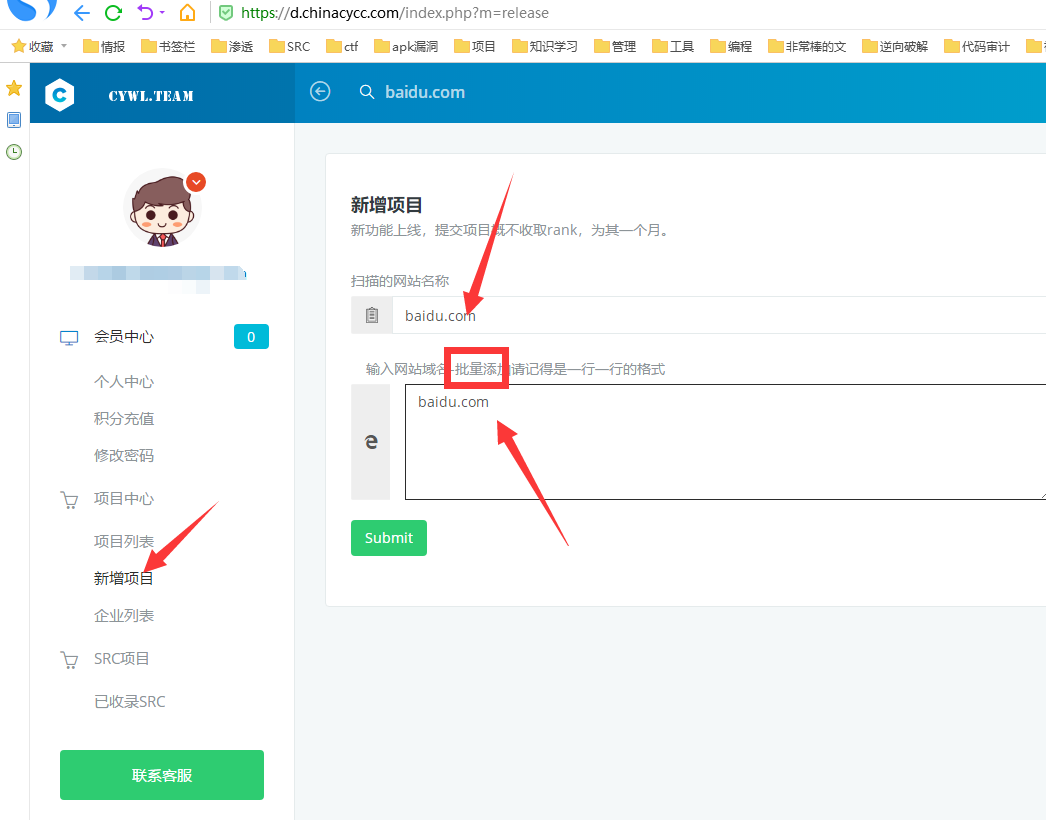
然后不到30秒就出结果了

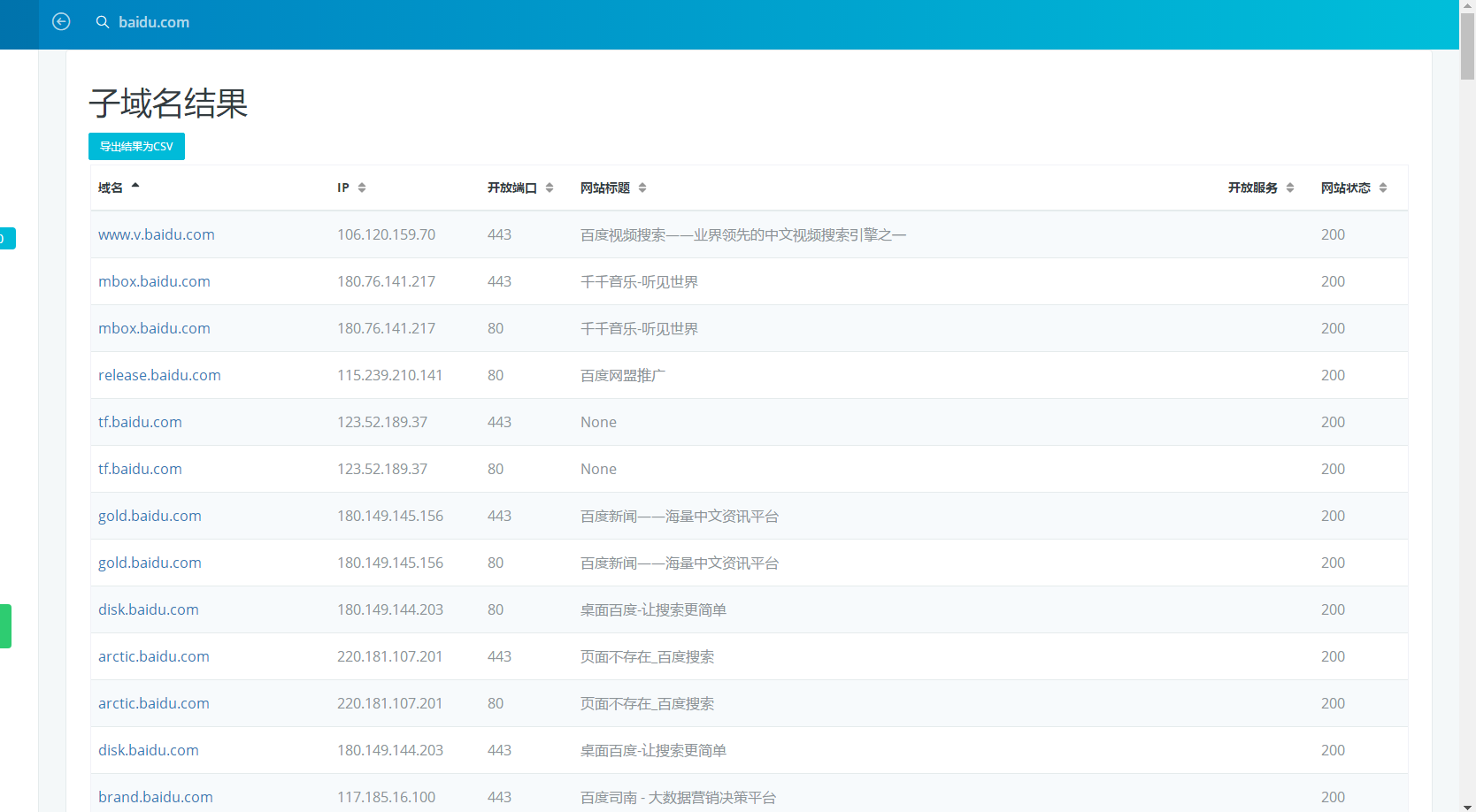
2、
http://z.zcjun.com/
https://phpinfo.me/domain/
端口信息收集
扫描端口并且标记可以爆破的服务
nmap 目标 --script=ftp-brute,imap-brute,smtp-brute,pop3-brute,mongodb-brute,redis-brute,ms-sql-brute,rlogin-brute,rsync-brute,mysql-brute,pgsql-brute,oracle-sid-brute,oracle-brute,rtsp-url-brute,snmp-brute,svn-brute,telnet-brute,vnc-brute,xmpp-brute
判断常见的漏洞并扫描端口
nmap 目标 --script=auth,vuln
精确判断漏洞并扫描端口
nmap 目标 --script=dns-zone-transfer,ftp-anon,ftp-proftpd-backdoor,ftp-vsftpd-backdoor,ftp-vuln-cve2010-4221,http-backup-finder,http-cisco-anyconnect,http-iis-short-name-brute,http-put,http-php-version,http-shellshock,http-robots.txt,http-svn-enum,http-webdav-scan,iis-buffer-overflow,iax2-version,memcached-info,mongodb-info,msrpc-enum,ms-sql-info,mysql-info,nrpe-enum,pptp-version,redis-info,rpcinfo,samba-vuln-cve-2012-1182,smb-vuln-ms08-067,smb-vuln-ms17-010,snmp-info,sshv1,xmpp-info,tftp-enum,teamspeak2-version
我喜欢这样做
1、扫描子域名
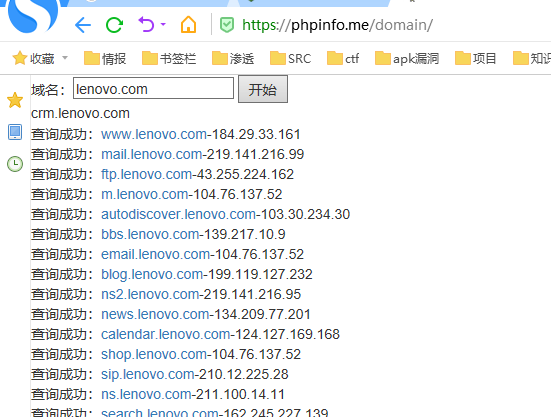
提取出域名/ip
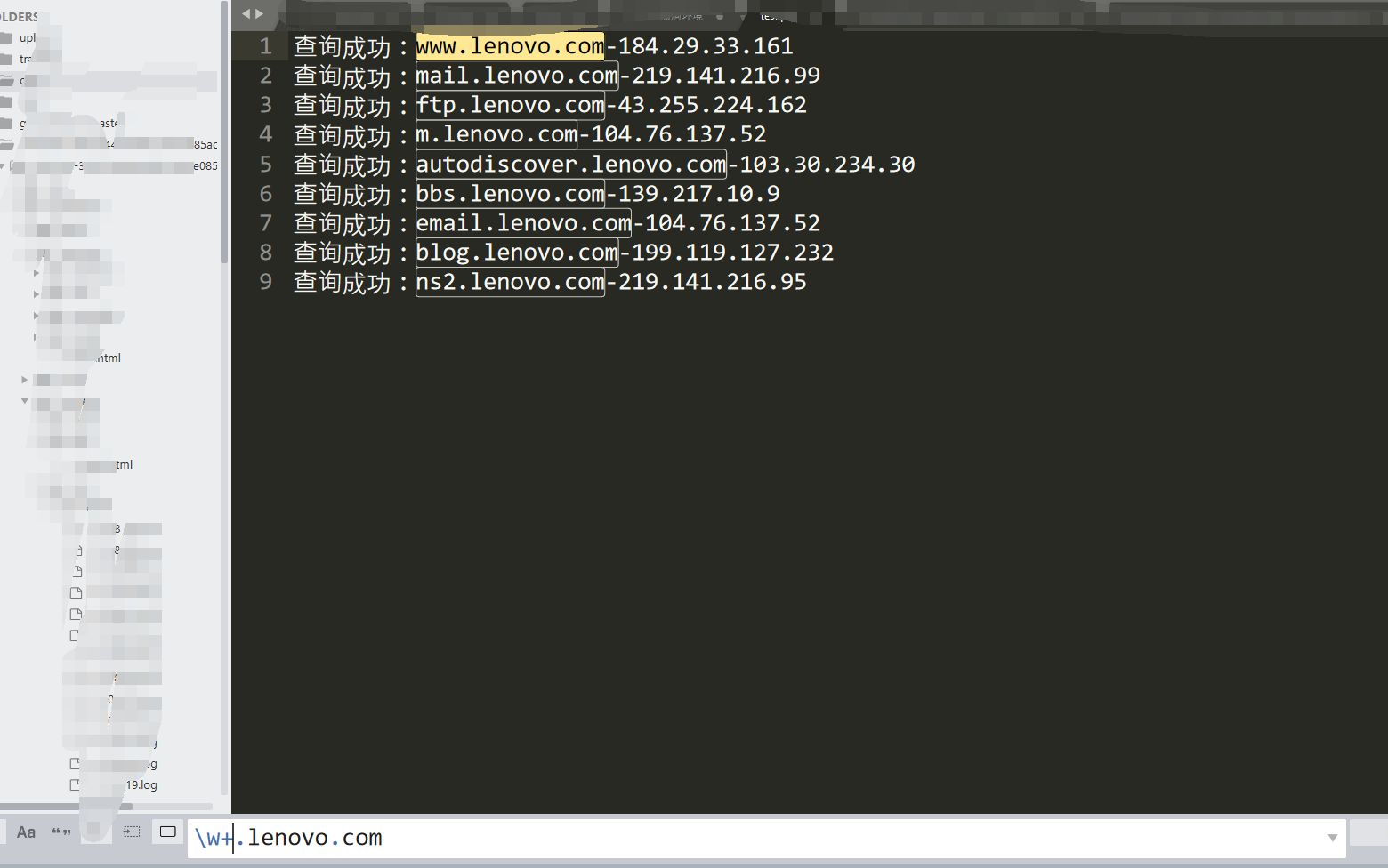
然后把域名放到975.txt
2、批量扫描端口和漏洞检测
nmap -iL 975.txt --script=auth,vuln,ftp-brute,imap-brute,smtp-brute,pop3-brute,mongodb-brute,redis-brute,ms-sql-brute,rlogin-brute,rsync-brute,mysql-brute,pgsql-brute,oracle-sid-brute,oracle-brute,rtsp-url-brute,snmp-brute,svn-brute,telnet-brute,vnc-brute,xmpp-brute > scan.txt
然后根据对应开放的端口进行针对性漏洞挖掘
c段信息收集
c段的话我一般都是使用iis put这款工具来扫描,可以自定义扫描1-255的端口并且还有返回服务器banner信息
自定义的端口
135,139,80,8080,15672,873,8983,7001,4848,6379,2381,8161,11211,5335,5336,7809,2181,9200,50070,50075,5984,2375,7809,16992,16993
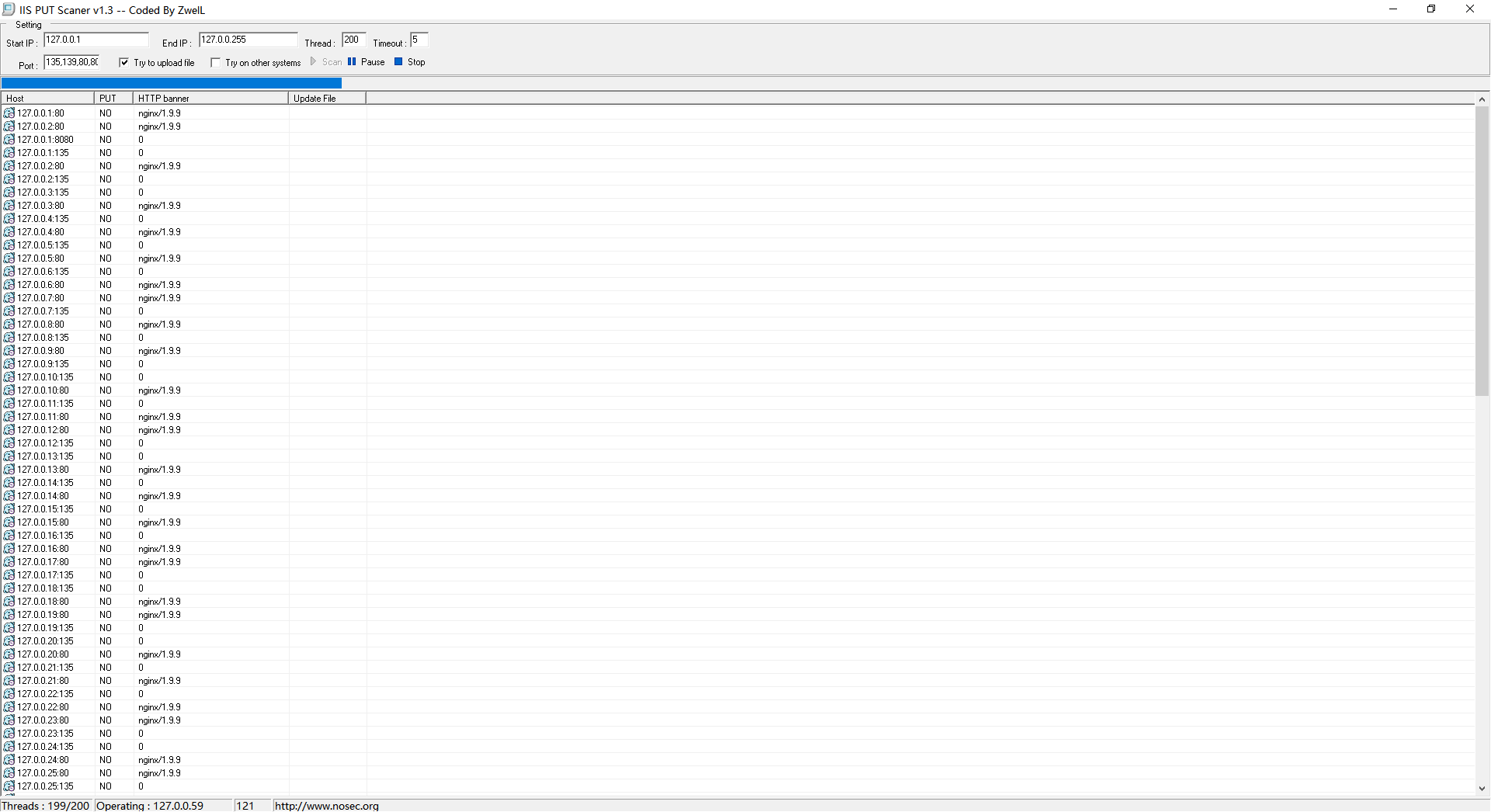
这里只是演示下他跑起来的美
目录信息收集
目录收集工具有很多,但是最看重的还是目录字典,之前我拿了很多工具的字典去重集合起来超级超级大,只不过是在之前电脑那里还原的时候忘记了备份、、、(说这句话主要是想让你们也可以这样子做,方便自己,然后发我一份,方便你我)
这里推荐一个工具7kbstorm
https://github.com/7kbstorm/7kbscan-WebPathBrute
像
403、404这种页面千万不要关闭,放目录里面扫就ok
谷歌语法收集铭感文件
最常见的就是用搜索引擎~
site:ooxx.com filetype:xls
首先试试百度
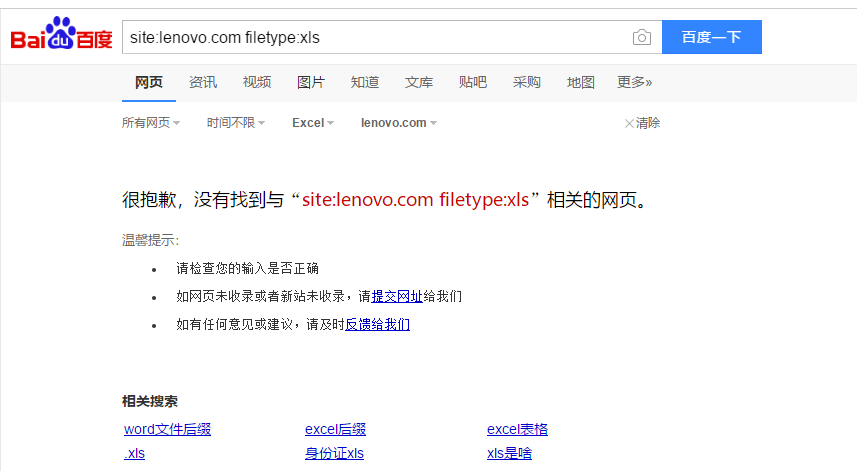
$!@!~~WDwadawicnm
试试必应
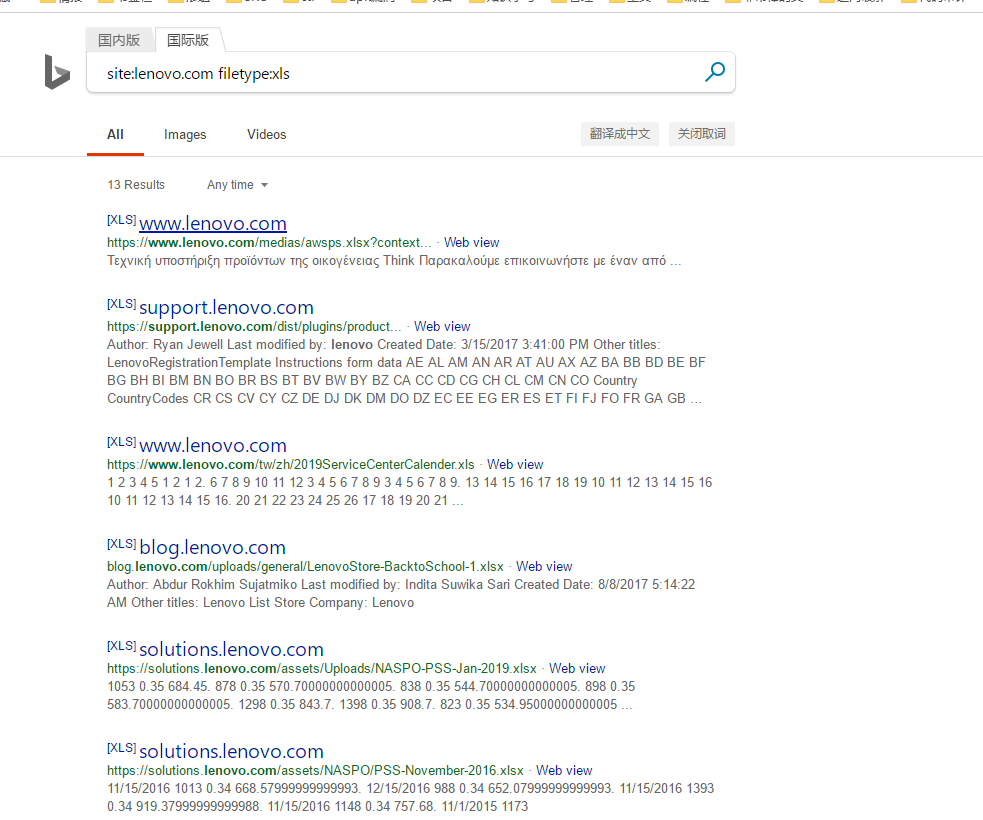
这里主要是收集网站敏感文件(比如目标的某个系统手册演示的截图中截图到了用户名,然后我们可以根据用户名来爆破密码;甚至可以看看有没有写系统默认密码,或者一些后台的目录路径,如果有目录就可以尝试对其访问,说不定有未授权~)
还能尝试对后台进行查找
site:xxx.xxx adminsite:xxx.xxx loginsite:xxx.xxx systemsite:xxx.xxx 管理site:xxx.xxx 登录site:xxx.xxx 内部site:xxx.xxx 系统
还可以查找邮箱,然后进行钓鱼
site:xxx.xxx 邮件site:xxx.xxx email
还可以查找qq群等,然后假装员工验证进去看群文件泄露了什么东东(这里有个技巧,去找客服聊天处,然后对整个过程抓包也就是看历史请求,如果运气好可能在请求的返回包中返回客服的姓名,如果只单纯的泄露了姓如张xx,那么你加群的时候就说你是小张工作号,说这个工作号的原因是可能小张已经在群里了)
注意事项:如果你是挖腾讯的话就不要看这条啦site:xxx.xxx qqsite:xxx.xxx 群site:xxx.xxx 企鹅site:xxx.xxx 腾讯
还可以对寻找一些公开的、危害大、普遍的漏洞的指纹,如下面的搜索jboss系统
site:ooxx.com inurl:jmx-console
小技巧
比如下面一个站存在越权(但是越权的对象很难猜测)
http://xxx.xxx.xxx/userinfo/?uid=2018-WOIDJWOIDJ-5201314
那么我们可以尝试用搜索引擎来找
site:xxx.xxx inurl=uid=20
利用云网盘搜索工具搜集敏感文件
公司员工可能把一些内部资料放在了公网网盘,然后被在线云网盘搜索的网站抓取了,我们就可以利用这个来对目标系统进行深入交流
我这边主要用凌风云搜索

个人喜欢直接输入厂商名字然后搜索(比较全),然后边看电视(最好看鬼片,鬼出来的阶段想着找找找)边搜索
利用gayhub来收集信息
1、打开gayhub
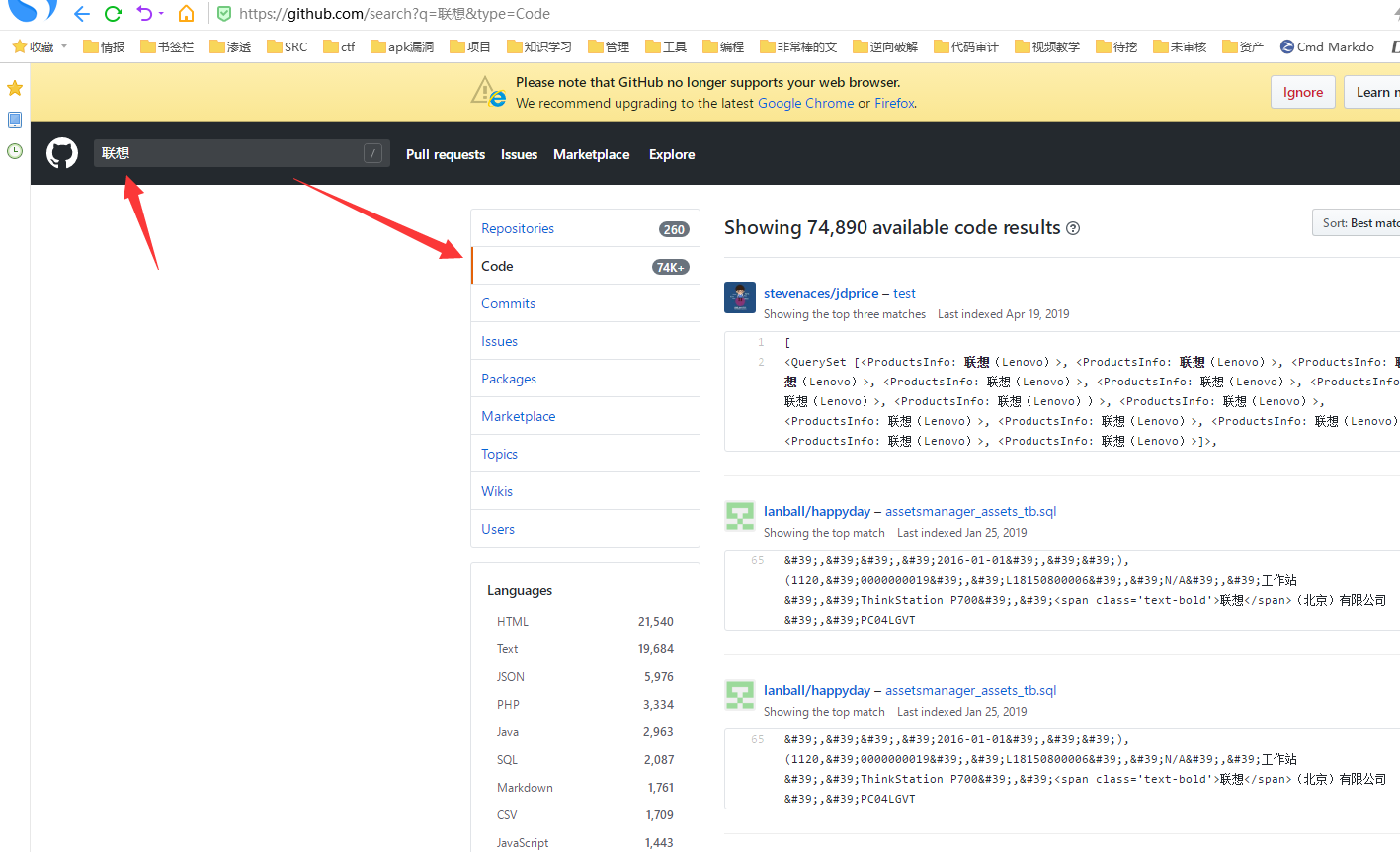
这里就是找gayhub全部开源项目内容中存在联想这个关键字的项目,这样子可以搜集到的方面更广,如果单纯只是对标题搜索,那么他们改成了lenovo你就搜不到了
然后说再多,也没这个好用
https://sec.xiaomi.com/article/37
针对网站性收集
1、把网站弄报错,看是什么cms,或者看返回包回显是什么中间件这些
2、看是linux还是window
如目标url是www.onlyfree.xxx/login,那么改成www.onlyfree.xxx/Login看看能不能访问,如果可以访问就可能是window,否则可能是linux
3、可以去云溪等在线识别指纹的网站看指纹信息
http://whatweb.bugscaner.com/look/
http://www.yunsee.cn/finger.html
4、对waf进行识别
这里有一款开源的识别工具,挺好用的
https://github.com/EnableSecurity/wafw00f
5、对网站whois查询看注册人、手机号、邮箱等(可以收集起来放到密码生成工具)
6、看html源代码,在一起项目测试的时候,我在找html源代码的时候发现一个注释的js文件,我将其打开后,里面的备注居然是配置信息。。。后台地址、管理员账号和密码等(可是我没get到shell,所以你要知道这回事而不要记住这件事)
7、网站真实ip识别,下面是我用的一个工具,但是我忘记哪里下载的了,我原封不漏的粘贴出来
################################################################### ▄▄▄▄ ▄▄▄ ▄▄▄▄ ▀ ▄### ▀ ▀█ ▄ ▄ ▄▄▄▄ █ ▄▀ ▀▄ ▄▄▄ ▄▄█▄▄### ▄▄▄▀ █▄█ █▀ ▀█ █ █ ▄ █ █ █### ▀█ ▄█▄ █ █ █ █ █ █ █### ▀▄▄▄█▀ ▄▀ ▀▄ ██▄█▀ ▄▄█▄▄ █▄▄█ ▄▄█▄▄ ▀▄▄### █### ▀###### name: xcdn.py### function: try to get the actual ip behind cdn### date: 2016-11-05### author: quanyechavshuo### blog: http://3xp10it.cc############################################################## usage:python3 xcdn.py www.baidu.comimport timeimport osos.system("pip3 install exp10it -U --no-cache-dir")from exp10it import figlet2filefiglet2file("3xp10it",0,True)time.sleep(1)from exp10it import CLIOutputfrom exp10it import get_root_domainfrom exp10it import get_string_from_commandfrom exp10it import get_http_or_httpsfrom exp10it import post_requestfrom exp10it import get_requestfrom exp10it import checkvpnimport sysimport reclass Xcdn(object):def __init__(self,domain):#必须保证连上了vpn,要在可以ping通google的条件下使用本工具,否则有些domain由于被GFW拦截无法正常访问会导致#本工具判断错误,checkvpn在可以ping通google的条件下返回1while 1:if checkvpn()==1:breakelse:time.sleep(1)print("vpn is off,connect vpn first")if domain[:4]=="http":print("domain format error,make sure domain has no http,like www.baidu.com but not \http://www.baidu.com")sys.exit(0)#首先保证hosts文件中没有与domain相关的项,有则删除相关domainPattern=domain.replace(".","\.")#下面的sed的正则中不能有\n,sed匹配\n比较特殊#http://stackoverflow.com/questions/1251999/how-can-i-replace-a-newline-n-using-sedcommand="sed -ri 's/.*\s+%s//' /etc/hosts" % domainPatternos.system(command)self.domain=domainself.http_or_https=get_http_or_https(self.domain)print('domain的http或https是:%s' % self.http_or_https)result=get_request(self.http_or_https+"://"+self.domain,'seleniumPhantomJS')self.domain_title=result['title']#下面调用相当于main函数的get_actual_ip_from_domain函数actual_ip = self.get_actual_ip_from_domain()if actual_ip != 0:print("恭喜,%s的真实ip是%s" % (self.domain, actual_ip))#下面用来存放关键返回值self.return_value=actual_ipdef domain_has_cdn(self):# 检测domain是否有cdn# 有cdn时,返回一个字典,如果cdn是cloudflare,返回{'has_cdn':1,'is_cloud_flare':1}# 否则返回{'has_cdn':1,'is_cloud_flare':0}或{'has_cdn':0,'is_cloud_flare':0}import reCLIOutput().good_print("现在检测domain:%s是否有cdn" % self.domain)has_cdn = 0# ns记录和mx记录一样,都要查顶级域名,eg.dig +short www.baidu.com ns VS dig +short baidu.com nsresult = get_string_from_command("dig ns %s +short" % get_root_domain(self.domain))pattern = re.compile(r"(cloudflare)|(cdn)|(cloud)|(fast)|(incapsula)|(photon)|(cachefly)|(wppronto)|(softlayer)|(incapsula)|(jsdelivr)|(akamai)", re.I)cloudflare_pattern = re.compile(r"cloudflare", re.I)if re.search(pattern, result):if re.search(cloudflare_pattern, result):print("has_cdn=1 from ns,and cdn is cloudflare")return {'has_cdn': 1, 'is_cloud_flare': 1}else:print("has_cdn=1 from ns")return {'has_cdn': 1, 'is_cloud_flare': 0}else:# 下面通过a记录个数来判断,如果a记录个数>1个,认为有cdnresult = get_string_from_command("dig a %s +short" % self.domain)find_a_record_pattern = re.findall(r"((\d{1,3}\.){3}\d{1,3})", result)if find_a_record_pattern:ip_count = 0for each in find_a_record_pattern:ip_count += 1if ip_count > 1:has_cdn = 1return {'has_cdn': 1, 'is_cloud_flare': 0}return {'has_cdn': 0, 'is_cloud_flare': 0}def get_domain_actual_ip_from_phpinfo(self):# 从phpinfo页面尝试获得真实ipCLIOutput().good_print("现在尝试从domain:%s可能存在的phpinfo页面获取真实ip" % self.domain)phpinfo_page_list = ["info.php", "phpinfo.php", "test.php", "l.php"]for each in phpinfo_page_list:url = self.http_or_https + "://" + self.domain + "/" + eachCLIOutput().good_print("现在访问%s" % url)visit = get_request(url,'seleniumPhantomJS')code = visit['code']content = visit['content']pattern = re.compile(r"remote_addr", re.I)if code == 200 and re.search(pattern, content):print(each)actual_ip = re.search(r"REMOTE_ADDR[^\.\d]+([\d\.]{7,15})[^\.\d]+", content).group(1)return actual_ip# return 0代表没有通过phpinfo页面得到真实ipreturn 0def flush_dns(self):# 这个函数用来刷新本地dns cache# 要刷新dns cache才能让修改hosts文件有效CLIOutput().good_print("现在刷新系统的dns cache")command = "service network-manager restart && /etc/init.d/networking force-reload"os.system(command)import timetime.sleep(3)def modify_hosts_file_with_ip_and_domain(self,ip):# 这个函数用来修改hosts文件CLIOutput().good_print("现在修改hosts文件")exists_domain_line = Falsewith open("/etc/hosts", "r+") as f:file_content = f.read()if re.search(r"%s" % self.domain.replace(".", "\."), file_content):exists_domain_line = Trueif exists_domain_line == True:os.system("sed -ri 's/.*%s.*/%s %s/' %s" % (self.domain.replace(".", "\."), ip, self.domain, "/etc/hosts"))else:os.system("echo %s %s >> /etc/hosts" % (ip, self.domain))def check_if_ip_is_actual_ip_of_domain(self,ip):# 通过修改hosts文件检测ip是否是domain对应的真实ip# 如果是则返回True,否则返回False#CLIOutput().good_print("现在通过修改hosts文件并刷新dns的方法检测ip:%s是否是domain:%s的真实ip" % (ip,self.domain))#python通过requests库或mechanicalsoup库或selenium_phantomjs来请求时不会被dns缓存影响,只会被hosts文件影响dns解析,人工用浏览器访问域名则会受dns缓存影响CLIOutput().good_print("现在通过修改hosts文件的方法检测ip:%s是否是domain:%s的真实ip" % (ip,self.domain))os.system("cp /etc/hosts /etc/hosts.bak")self.modify_hosts_file_with_ip_and_domain(ip)#python通过requests库或mechanicalsoup库或selenium_phantomjs来请求时不会被dns缓存影响,只会被hosts文件影响dns解析,人工用浏览器访问域名则会受dns缓存影响#self.flush_dns()hosts_changed_domain_title= get_request(self.http_or_https + "://%s" % self.domain,'selenium_phantom_js')['title']os.system("rm /etc/hosts && mv /etc/hosts.bak /etc/hosts")#这里要用title判断,html判断不可以,title相同则认为相同if self.domain_title == hosts_changed_domain_title:CLIOutput().good_print("检测到真实ip!!!!!!",'red')return Trueelse:CLIOutput().good_print("当前ip不是域名的真实ip",'yellow')return Falsedef get_c_80_or_443_list(self,ip):# 得到ip的整个c段的开放80端口或443端口的ip列表if "not found" in get_string_from_command("masscan"):#这里不用nmap扫描,nmap扫描结果不准os.system("apt-get install masscan")if self.http_or_https=="http":scanPort=80CLIOutput().good_print("现在进行%s的c段开了80端口机器的扫描" % ip)if self.http_or_https=="https":scanPort=443CLIOutput().good_print("现在进行%s的c段开了443端口机器的扫描" % ip)masscan_command = "masscan -p%d %s/24 > /tmp/masscan.out" % (scanPort,ip)os.system(masscan_command)with open("/tmp/masscan.out", "r+") as f:strings = f.read()#os.system("rm /tmp/masscan.out")import reallIP=re.findall(r"((\d{1,3}\.){3}\d{1,3})",strings)ipList=[]for each in allIP:ipList.append(each[0])print(ipList)return ipListdef check_if_ip_c_machines_has_actual_ip_of_domain(self,ip):# 检测ip的c段有没有domain的真实ip,如果有则返回真实ip,如果没有则返回0CLIOutput().good_print("现在检测ip为%s的c段中有没有%s的真实ip" % (ip,self.domain))target_list=self.get_c_80_or_443_list(ip)for each_ip in target_list:if True == self.check_if_ip_is_actual_ip_of_domain(each_ip):return each_ipreturn 0def get_ip_from_mx_record(self):# 从mx记录中得到ip列表,尝试从mx记录中的c段中找真实ipprint("尝试从mx记录中找和%s顶级域名相同的mx主机" % self.domain)import socket# domain.eg:www.baidu.comfrom exp10it import get_root_domainroot_domain = get_root_domain(self.domain)from exp10it import get_string_from_commandresult = get_string_from_command("dig %s +short mx" % root_domain)sub_domains_list = re.findall(r"\d{1,} (.*\.%s)\." % root_domain.replace(".", "\."), result)ip_list = []for each in sub_domains_list:print(each)ip = socket.gethostbyname_ex(each)[2]if ip[0] not in ip_list:ip_list.append(ip[0])return ip_listdef check_if_mx_c_machines_has_actual_ip_of_domain(self):# 检测domain的mx记录所在ip[或ip列表]的c段中有没有domain的真实ip# 有则返回真实ip,没有则返回0CLIOutput().good_print("尝试从mx记录的c段中查找是否存在%s的真实ip" % self.domain)ip_list = self.get_ip_from_mx_record()if ip_list != []:for each_ip in ip_list:result = self.check_if_ip_c_machines_has_actual_ip_of_domain(each_ip)if result != 0:return resultelse:continuereturn 0def get_ip_value_from_online_cloudflare_interface(self):# 从在线的cloudflare查询真实ip接口处查询真实ip# 如果查询到真实ip则返回ip值,如果没有查询到则返回0CLIOutput().good_print("现在从在线cloudflare类型cdn查询真实ip接口尝试获取真实ip")url = "http://www.crimeflare.com/cgi-bin/cfsearch.cgi"post_data = 'cfS=%s' % self.domaincontent = post_request(url, post_data)findIp = re.search(r"((\d{1,3}\.){3}\d{1,3})", content)if findIp:return findIp.group(1)return 0def get_actual_ip_from_domain(self):# 尝试获得domain背后的真实ip,前提是domain有cdn# 如果找到了则返回ip,如果没有找到返回0CLIOutput().good_print("进入获取真实ip函数,认为每个domain都是有cdn的情况来处理")import sockethas_cdn_value = self.domain_has_cdn()if has_cdn_value['has_cdn'] == 1:CLIOutput().good_print("检测到domain:%s的A记录不止一个,认为它有cdn" % self.domain)passelse:CLIOutput().good_print("Attention...!!! Domain doesn't have cdn,I will return the only one ip")true_ip = socket.gethostbyname_ex(self.domain)[2][0]return true_ip# 下面尝试通过cloudflare在线查询真实ip接口获取真实ipif has_cdn_value['is_cloud_flare'] == 1:ip_value = self.get_ip_value_from_online_cloudflare_interface()if ip_value != 0:return ip_valueelse:pass# 下面尝试通过可能存在的phpinfo页面获得真实ipip_from_phpinfo = self.get_domain_actual_ip_from_phpinfo()if ip_from_phpinfo == 0:passelse:return ip_from_phpinfo# 下面通过mx记录来尝试获得真实ipresult = self.check_if_mx_c_machines_has_actual_ip_of_domain()if result == 0:passelse:return resultprint("很遗憾,在下认为%s有cdn,但是目前在下的能力没能获取它的真实ip,当前函数将返回0" % self.domain)return 0if __name__ == '__main__':import sysdomain=sys.argv[1]Xcdn(domain)
8、服务器ssh配置信息
丢工具:https://github.com/mozilla/ssh_scan
9、敏感文件爆破
svn源代码泄露使用svn版本控制系统时,错误操作将.svn文件存放,那么久可以看他SVN服务器账号密码等信息
http://xxx.xxx.xxx/.svn/entries
10、根据目标系统情况
根据目标系统情况是因为看他对应的系统是什么对应有什么漏洞,下面这个是tomcat的session泄露
/examples/servlets/servlet/SessionExample/examples//examples/servlets/servlet/SessionExample/examples/
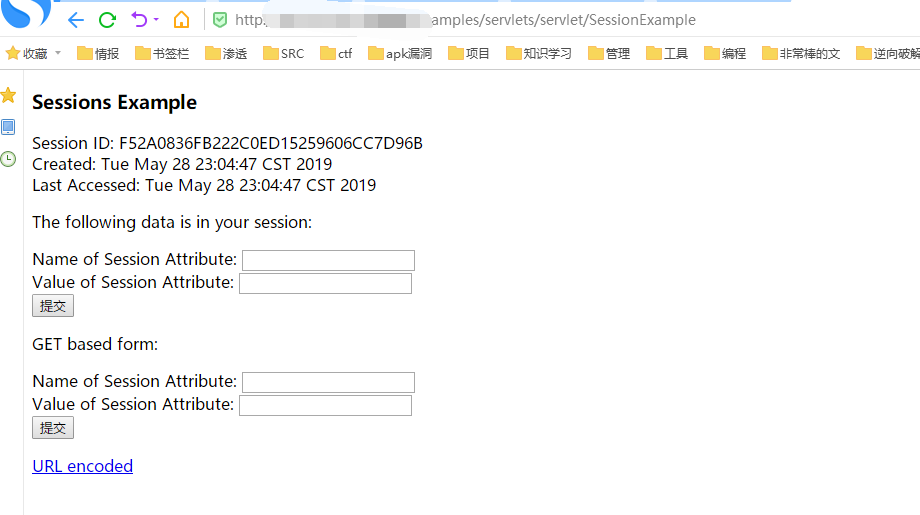
敏感目录泄露
WEB-INF/web.xml泄露
WEB-INF是Java的WEB应用的安全目录。如果想在页面中直接访问其中的文件,必须通过web.xml文件对要访问的文件进行相应映射才能访问
/WEB-INF/config/jdbc.properties/WEB-INF/web.xml/WEB-INF/classes//WEB-INF/lib//WEB-INF/src//WEB-INF/database.properties
bzr泄露
通过它我们可以看项目历史
http://xxx.xxx.xxx/.bzr/
- 网站源代码泄露
不多介绍,可能管理员觉得网站不安全,需要我们审计一下
www.zipwww.tar.gzwww.rarweb.zipweb.rar...
这些有很多,,不一一详细,后面我会将这些全部集合在一个字典里,然后我们可以放入目录遍历的工具里批量扫~
利用shodan、fofa等收集信息
查找标题是携程并且语言是国语的站点
https://www.shodan.io/search?query=http.title:"携程" country:"CN"
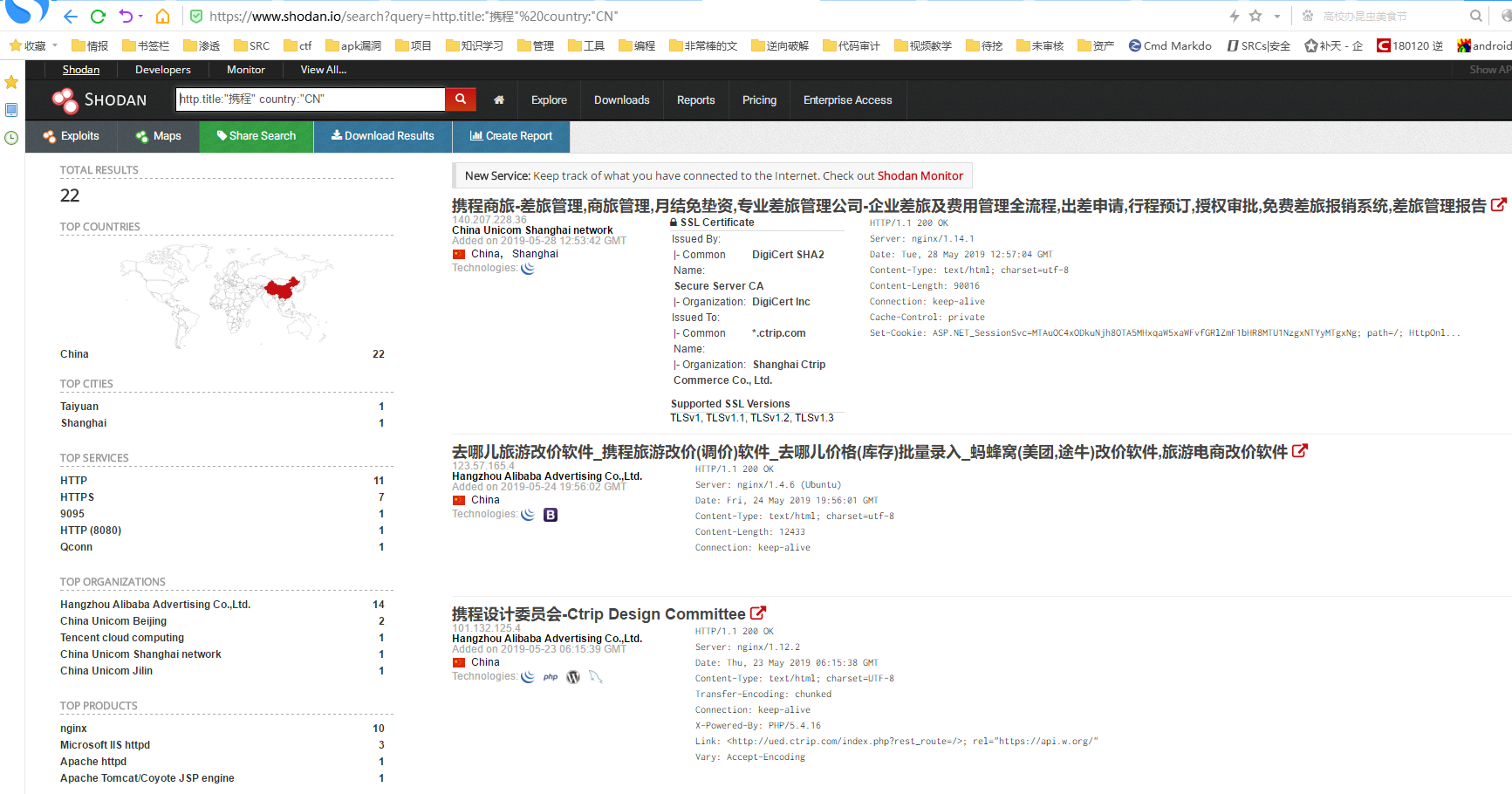
我们可以将其收藏为文件夹,方便下次打开,然后记录时间,看看有没有新上线的(这里已经有监控的功能,各位师傅可以去看看米斯特大佬写的shodan监控文章,很有趣很实用)
shodan、fofa不多介绍了,有对应的手册,见的肯定比我好
思路扩展
思路扩展就是在a功能点中找出b功能点,以此类推
比如一些后台登录是
http://xxx.xxx.xxx/admin-login
我们是不是可以尝试吧login改成register来注册
再比如获取用户手机号的接口(这里不存在越权)
http://xxx.xxx.xxx/user/GetPhone/?id=1
然后我们把GetPhone改成GetPasswd或者GetPwd或者GetPassword然后id就可能可以越权,或者这里可以json劫持或者origin劫持等,我们可以诱导用户点开来劫持账号密码
或者还是看源代码,然后搜索hidden(滑稽),我们可能可能会找到敏感操作的按钮,然后管理员也知道敏感,将其"隐藏"了,我们可以根据这个来搜索然后访问他,嘿嘿嘿(之前对一个小站点进行挖掘的时候我hidden找居然找到了不可描述的目录下面放着不可描述的电影,当时我的心情是非常拒绝的,经过几小时的思考我迅速的将那个目录关闭了,毕竟我是祖国的花朵)
这里有很多是adrian师傅与我分享的,然后暂时只写那么多吧(其实还有几个,怕触犯到权什么的就是他给你学了但不给我写的那种,很麻烦所以就以后有机会再写吧),如果遇到了更多我会补充
来源于网络,回馈于网络
作者qq:1900065568
经济条件的情况下表哥们可以来我小密圈支持,一起交流一起进步

